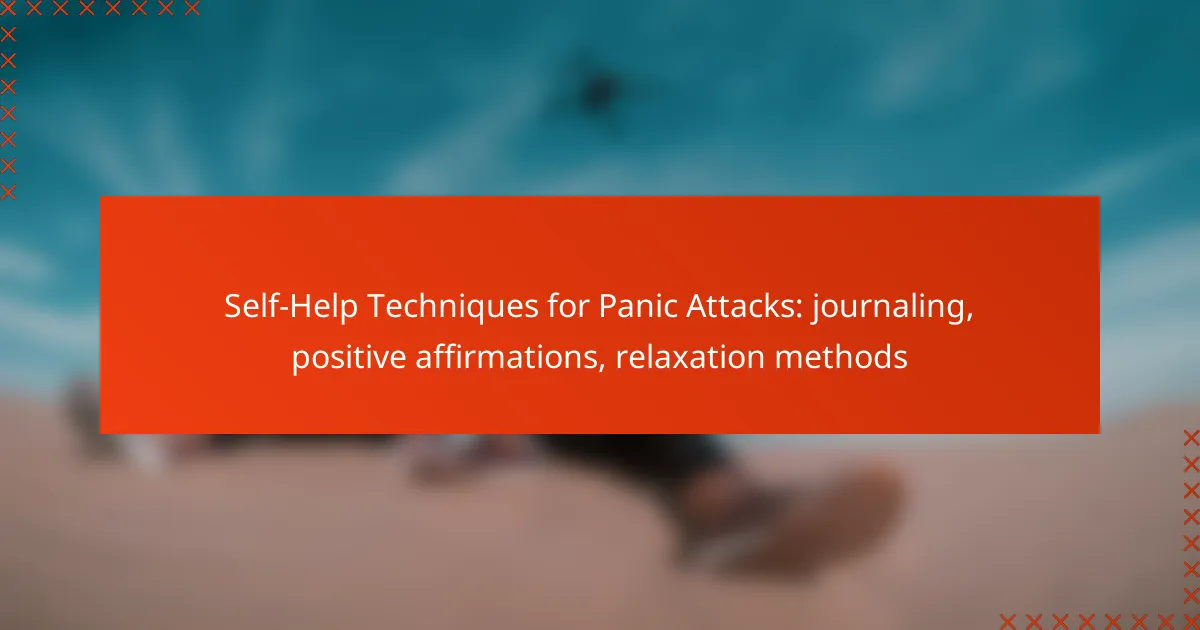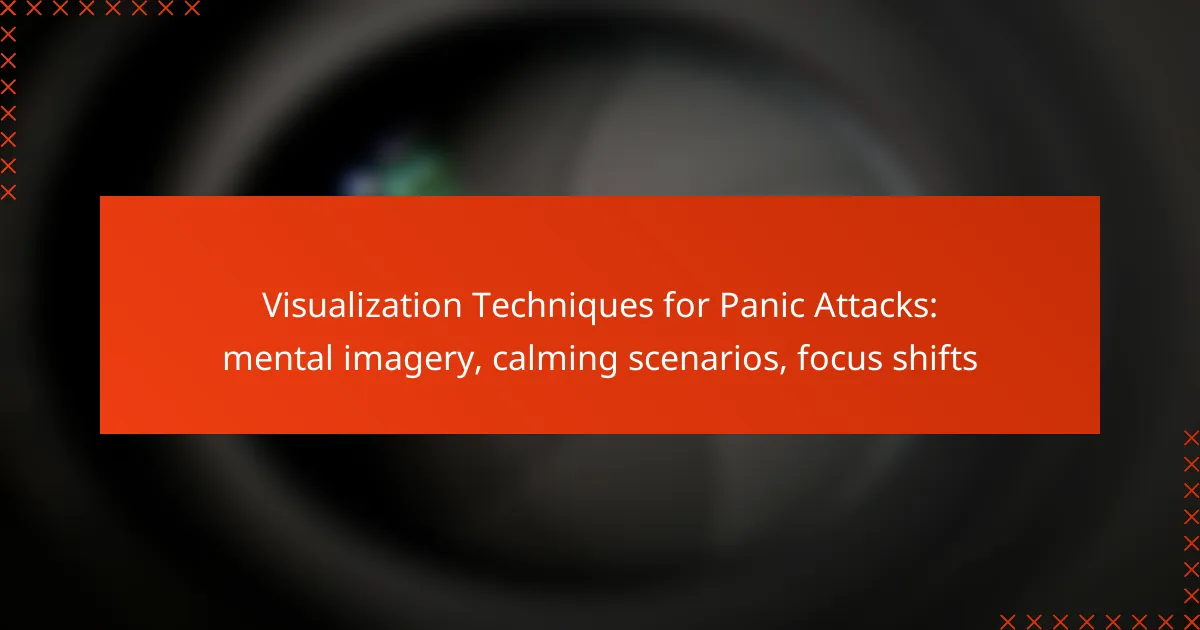Self-help techniques such as journaling, positive affirmations, and relaxation methods can effectively reduce panic attacks. These strategies empower individuals to manage their anxiety and regain control over their emotional responses, fostering a sense of calm and resilience in challenging situations.
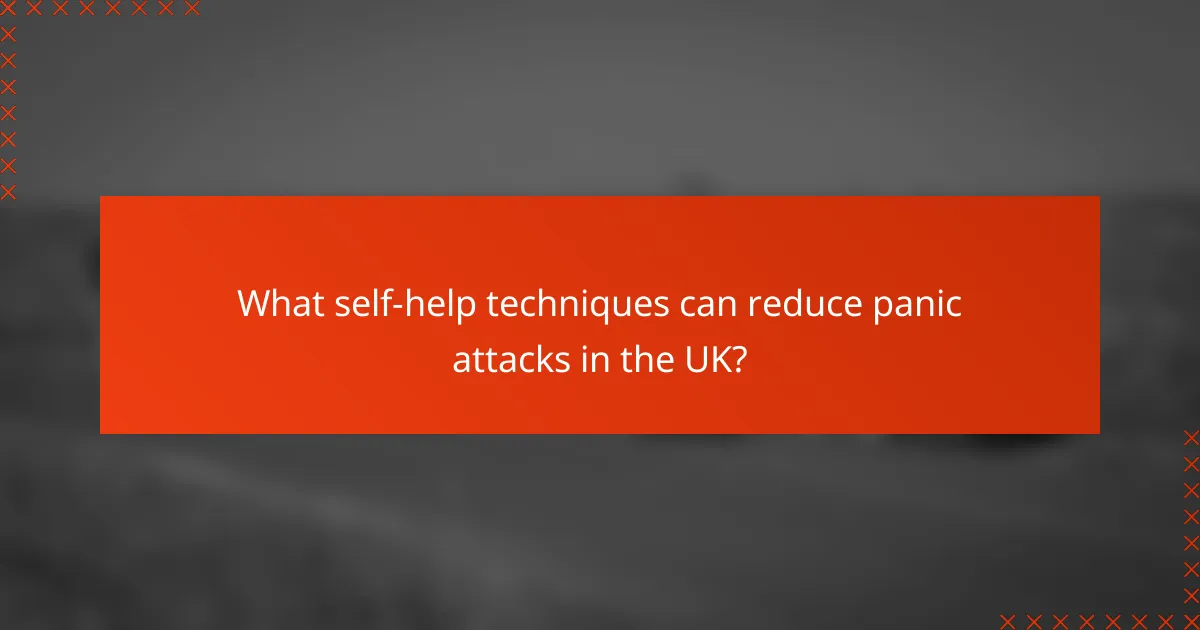
What self-help techniques can reduce panic attacks in the UK?
Self-help techniques such as journaling, positive affirmations, and relaxation methods can effectively reduce panic attacks in the UK. These strategies empower individuals to manage their anxiety and regain control over their emotional responses.
Journaling for emotional clarity
Journaling helps individuals articulate their thoughts and feelings, providing emotional clarity during panic attacks. By writing down triggers and emotions, one can identify patterns and develop coping strategies.
To start journaling, set aside a few minutes each day to write freely about your experiences and feelings. Focus on specific incidents that lead to panic, noting any recurring themes or thoughts that arise.
Positive affirmations for self-empowerment
Positive affirmations can boost self-esteem and counter negative thoughts associated with panic attacks. By repeating empowering statements, individuals can reframe their mindset and reduce feelings of helplessness.
Choose affirmations that resonate personally, such as “I am in control of my thoughts” or “I can handle this situation.” Repeat these affirmations daily, especially during moments of anxiety, to reinforce a positive self-image.
Relaxation methods for immediate relief
Relaxation techniques, such as deep breathing and progressive muscle relaxation, can provide immediate relief during a panic attack. These methods help calm the nervous system and reduce physical symptoms of anxiety.
To practice deep breathing, inhale slowly through your nose for a count of four, hold for four, and exhale through your mouth for another four. Repeat this cycle several times until you feel more centered. Consider incorporating these techniques into your daily routine to build resilience against future panic attacks.
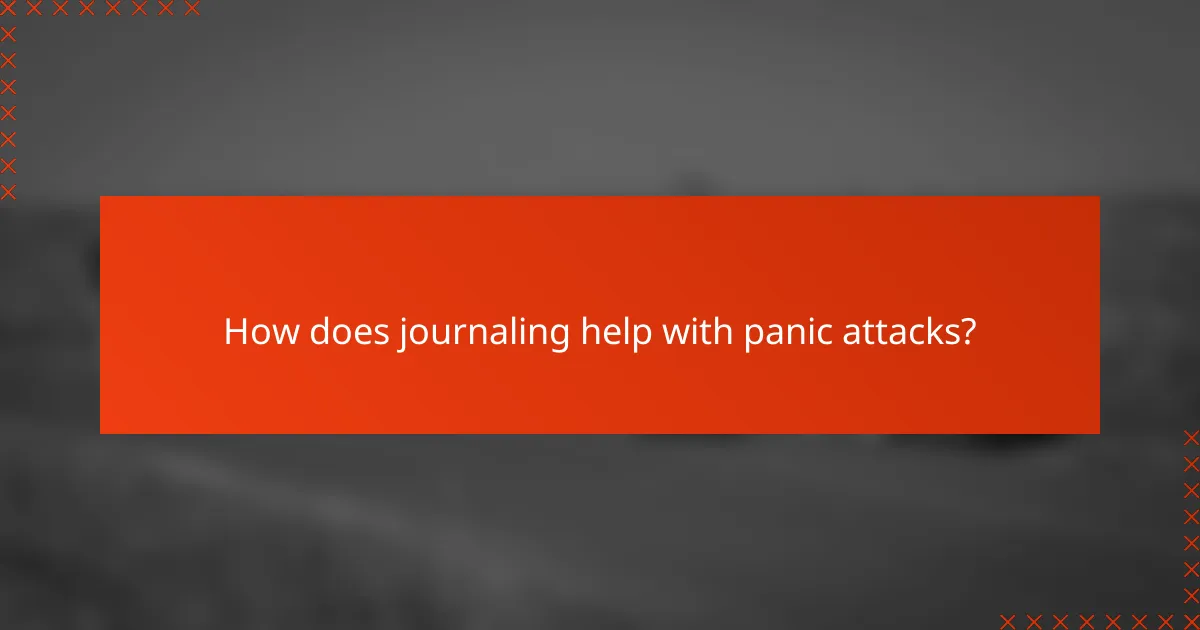
How does journaling help with panic attacks?
Journaling can be an effective tool for managing panic attacks by providing a safe space to explore thoughts and feelings. Writing about experiences helps individuals identify patterns and triggers, leading to better understanding and coping strategies.
Identifying triggers through writing
Writing regularly about daily experiences can help pinpoint specific situations or thoughts that lead to panic attacks. By reflecting on these entries, individuals can recognize recurring themes, such as stressful events or negative self-talk, that may contribute to their anxiety.
To enhance this process, consider keeping a dedicated panic attack journal. Note the date, time, and context of each episode, as well as any preceding thoughts or feelings. Over time, this can reveal clear triggers and patterns, allowing for proactive management.
Processing emotions effectively
Journaling provides an outlet for processing complex emotions associated with panic attacks. Writing down feelings can help clarify thoughts and reduce emotional intensity, making it easier to cope with anxiety.
Incorporate techniques like free writing or prompts that encourage exploration of specific emotions. For instance, ask yourself questions like “What was I feeling before the panic attack?” or “What thoughts were racing through my mind?” This can foster deeper self-awareness and emotional regulation.
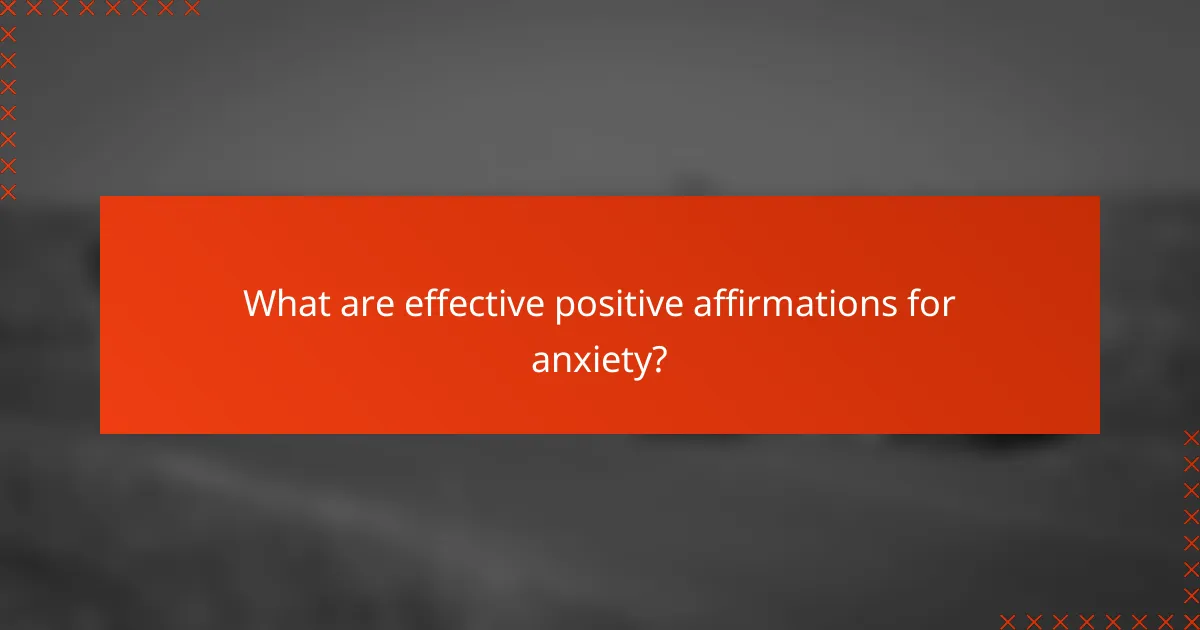
What are effective positive affirmations for anxiety?
Effective positive affirmations for anxiety are short, powerful statements that help challenge and overcome negative thoughts associated with panic and anxiety. By repeating these affirmations, individuals can rewire their thinking patterns, fostering a sense of calm and control during stressful moments.
Examples of affirmations for panic relief
Common affirmations for panic relief include phrases such as “I am safe and in control,” “This feeling is temporary,” and “I can handle whatever comes my way.” These statements serve to ground individuals in the present moment and remind them of their resilience.
When using affirmations, it can be helpful to choose ones that resonate personally. For instance, someone might say, “I breathe in calmness and exhale tension,” which can be particularly effective during a panic attack.
Creating personalized affirmations
To create personalized affirmations, start by identifying specific fears or negative thoughts that trigger anxiety. Transform these thoughts into positive statements, such as changing “I can’t handle this” to “I am capable and strong.” Tailoring affirmations to individual experiences makes them more impactful.
Consider writing down your affirmations and placing them in visible areas, such as on a mirror or in a journal. Regularly repeating these personalized affirmations can reinforce positive thinking and help alleviate anxiety over time.
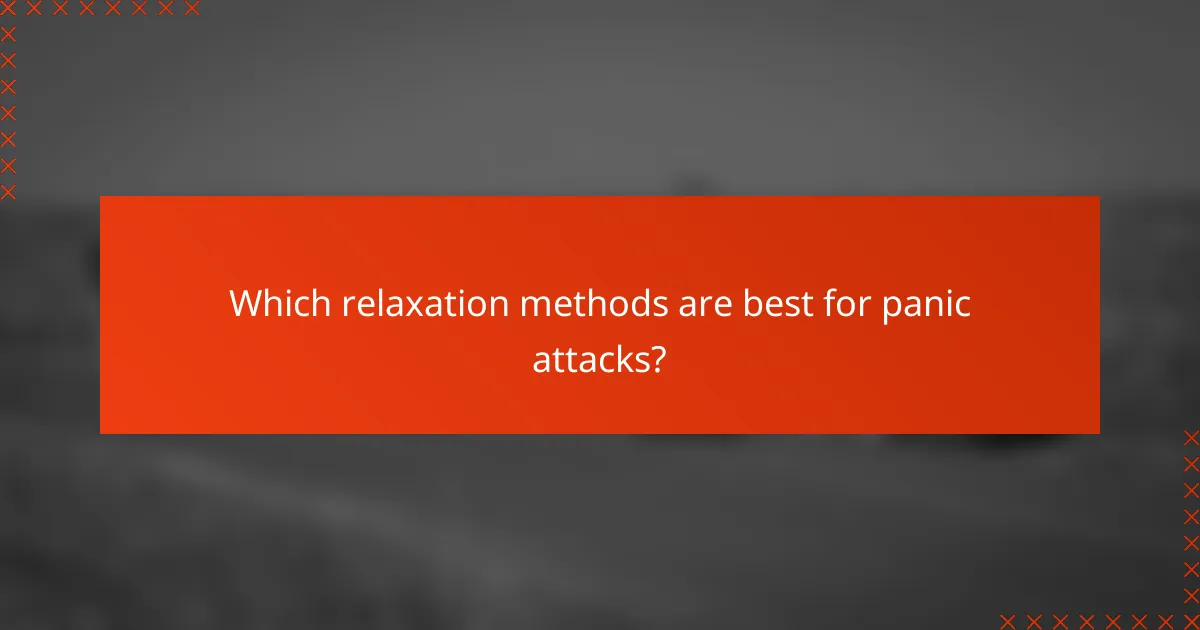
Which relaxation methods are best for panic attacks?
Effective relaxation methods for panic attacks include deep breathing exercises and progressive muscle relaxation. These techniques help calm the mind and body, reducing anxiety and preventing panic from escalating.
Deep breathing exercises
Deep breathing exercises focus on slow, controlled breaths to help lower heart rate and promote relaxation. A common technique is the 4-7-8 method, where you inhale for 4 seconds, hold for 7 seconds, and exhale for 8 seconds. Practicing this for a few minutes can significantly alleviate feelings of panic.
To enhance effectiveness, find a quiet space and sit or lie down comfortably. Concentrate on your breath and try to clear your mind of distractions. Regular practice can improve your ability to manage panic attacks when they arise.
Progressive muscle relaxation
Progressive muscle relaxation (PMR) involves tensing and then relaxing different muscle groups to reduce physical tension associated with anxiety. Start from your toes and work your way up to your head, holding each muscle tense for a few seconds before releasing. This method can take about 10-15 minutes to complete.
As you practice PMR, pay attention to the contrast between tension and relaxation in your body. This awareness can help you recognize early signs of panic and respond more effectively. Incorporating PMR into your daily routine can build resilience against stress and anxiety.
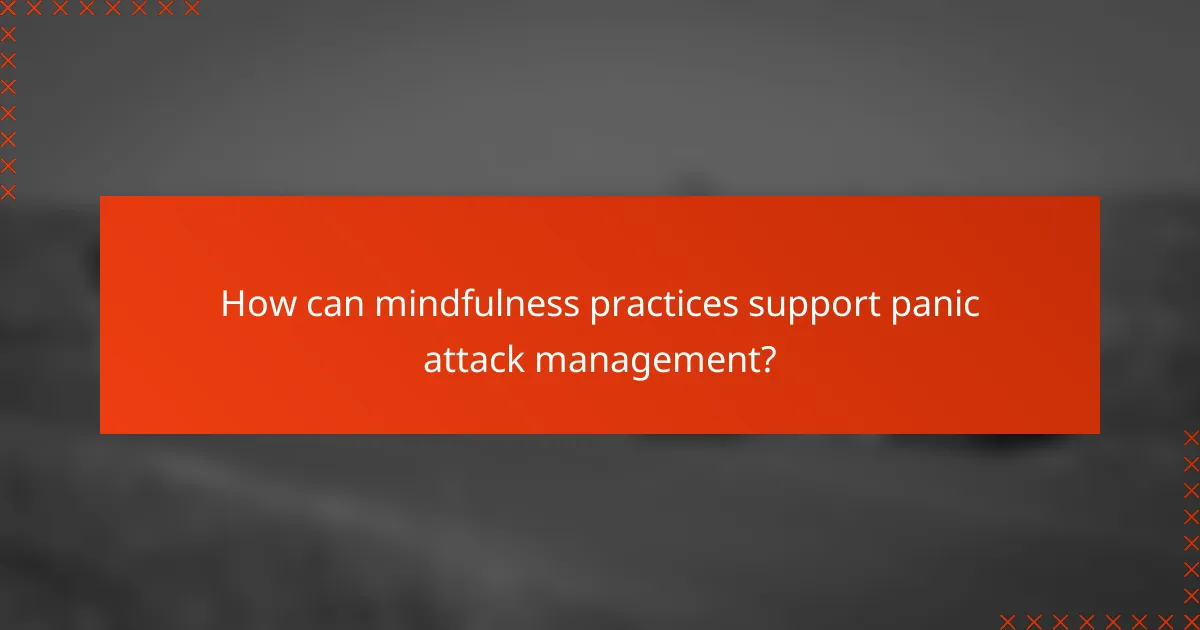
How can mindfulness practices support panic attack management?
Mindfulness practices can significantly aid in managing panic attacks by promoting awareness and acceptance of thoughts and feelings without judgment. Techniques such as meditation and mindfulness exercises help individuals regain control during moments of anxiety, reducing the intensity and frequency of panic episodes.
Meditation techniques for anxiety
Meditation techniques, such as focused breathing and body scans, can be effective in alleviating anxiety symptoms. Focused breathing involves concentrating on your breath, inhaling deeply through the nose and exhaling slowly through the mouth, which can help calm the nervous system. Body scans encourage awareness of physical sensations, allowing individuals to identify and release tension in different areas of the body.
To start, set aside a few minutes each day to practice meditation in a quiet space. Use guided meditation apps or videos to assist you, especially if you are new to the practice. Aim for sessions lasting between 5 to 20 minutes, gradually increasing the duration as you become more comfortable.
Mindfulness exercises in daily life
Incorporating mindfulness exercises into daily routines can enhance overall well-being and reduce panic attack triggers. Simple practices like mindful walking, where you focus on the sensations of each step, or mindful eating, where you savor each bite, can ground you in the present moment. These exercises help divert attention from anxious thoughts and foster a sense of calm.
Consider setting reminders throughout the day to pause and engage in mindfulness. Techniques such as the “5-4-3-2-1” grounding exercise, which involves identifying five things you can see, four things you can touch, three things you can hear, two things you can smell, and one thing you can taste, can be particularly helpful during stressful moments. Regular practice can build resilience against anxiety and enhance your ability to manage panic attacks effectively.

What are the prerequisites for effective self-help techniques?
Effective self-help techniques for managing panic attacks require self-awareness and a conducive environment. Understanding your personal triggers and creating a supportive atmosphere are essential steps in utilizing methods like journaling, positive affirmations, and relaxation techniques.
Understanding personal triggers
Identifying personal triggers is crucial for managing panic attacks effectively. Triggers can range from specific situations, such as crowded places, to internal factors like stress or fatigue. Keeping a journal to note when panic attacks occur can help pinpoint these triggers.
Once you recognize your triggers, you can develop strategies to cope with them. For example, if social situations induce anxiety, practice gradual exposure by starting with smaller gatherings before attending larger events. This can build confidence and reduce panic responses over time.
Establishing a supportive environment
A supportive environment plays a vital role in managing panic attacks. Surround yourself with understanding friends and family who can provide reassurance during difficult moments. Open communication about your experiences can foster empathy and support.
Additionally, consider creating a calming space at home where you can practice relaxation techniques. This space should be free from distractions and equipped with items that promote tranquility, such as soft lighting, comfortable seating, or soothing music. Regularly spending time in this environment can help reinforce a sense of safety and calm.

What role does professional therapy play in panic attack treatment?
Professional therapy is crucial in treating panic attacks as it provides structured support and tailored strategies. Therapists can help individuals understand their triggers, develop coping mechanisms, and work through underlying issues contributing to anxiety.
Complementing self-help techniques
Self-help techniques, such as journaling, positive affirmations, and relaxation methods, can significantly enhance the effectiveness of professional therapy. Journaling allows individuals to track their thoughts and emotions, helping to identify patterns and triggers. Positive affirmations can reinforce self-belief and reduce anxiety, while relaxation methods like deep breathing or meditation can help manage symptoms in the moment.
Combining these self-help strategies with therapy can create a comprehensive approach to managing panic attacks. For example, a therapist might encourage a patient to practice deep breathing exercises during sessions and then use journaling to reflect on their experiences afterward.
When to seek professional help
It’s essential to seek professional help if panic attacks become frequent or severely impact daily life. Signs that indicate the need for therapy include persistent feelings of fear, avoidance of certain situations, or physical symptoms that interfere with normal activities. If self-help techniques do not provide relief, consulting a mental health professional is advisable.
Additionally, if panic attacks are accompanied by other mental health issues, such as depression or substance abuse, professional intervention is critical. Early intervention can lead to more effective treatment outcomes and help individuals regain control over their lives.

What emerging trends are shaping self-help for panic attacks?
Emerging trends in self-help for panic attacks focus on personalized approaches, integrating technology, and utilizing holistic methods. These trends emphasize the importance of tailored strategies that cater to individual needs, making self-help more accessible and effective.
Integration of technology in self-help
The integration of technology in self-help for panic attacks includes mobile apps, online therapy platforms, and virtual support groups. These tools provide users with immediate access to resources and support, allowing them to manage their symptoms more effectively and at their convenience.
Popular apps often feature guided meditations, journaling prompts, and mood tracking, which can help individuals identify triggers and patterns. For example, an app might allow users to log their feelings and receive personalized coping strategies based on their entries.
While technology offers many benefits, it is crucial to choose reputable platforms that prioritize user privacy and data security. Users should also be cautious of over-reliance on digital tools and ensure they complement, rather than replace, traditional therapeutic methods.
